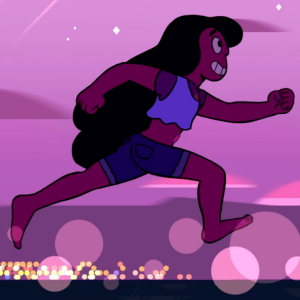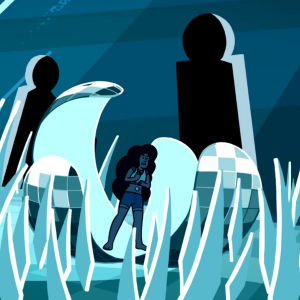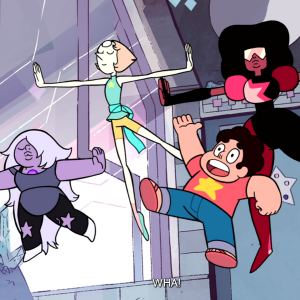 “Alone Together” should be shown in schools. This episode of Cartoon Network’s Steven Universe is the best exploration and communication of childhood intimacy and active consent that I’ve ever seen. Katie Mitroff, Hilary Florido, and Rebecca Sugar have crafted a story that does what science fiction does best: explore big concepts through powerful metaphor.
“Alone Together” should be shown in schools. This episode of Cartoon Network’s Steven Universe is the best exploration and communication of childhood intimacy and active consent that I’ve ever seen. Katie Mitroff, Hilary Florido, and Rebecca Sugar have crafted a story that does what science fiction does best: explore big concepts through powerful metaphor.
Everyone should watch this episode.
“Alone Together” teaches that intimate relationships are built on trust and mutuality, that intimacy requires active and ongoing mutual consent, and that while intimate acts are important and can be life-changing, they don’t mean the loss of something unrecoverable. It teaches all this through the metaphor of dance, a form of intimacy that is accessible and safe for young people.
I’ll explore the story of this episode, discussing its ending as well as the unexpected character backstory revealed in “Jail Break.”
Dance Lessons
In the beginning of “Alone Together,” the Gems are trying to teach Steven how to perform fusion. This is done through dance, requiring the fusion members to “synchronize” their bodies and minds in rhythm. Dance is culturally associated with sexuality, and throughout this episode dancing and fusion serve as metaphors for intimate relationships. The Gems speculate on whether Steven will ever be able to fuse; Pearl says “who knows, in few years…?” She trails off, as they’re not sure if a half-human can perform fusion.
The next scene has Steven hanging out on the beach with his close human friend Connie. He speaks of fusion in the vague, confused way that children speak about adult things, and Connie, who has previously demonstrated social anxiety, expresses fright at the idea of dancing around other people: “I just couldn’t stop thinking about everyone staring at me,” she says. Steven then puts on music and invites her to dance with him.
Throughout this scene, Steven never pressures Connie. Whenever she seems nervous, he physically steps away, giving her the opportunity to choose whether or not to continue. It isn’t manipulation on Steven’s part, either; the dancing is always phrased as something they are doing together, and each partner takes turns letting the other lead. Near the end of the scene, they start getting silly and clowning around. They bump into each other and Connie catches Steven. As they look into each others’ eyes and laugh, Steven’s gem begins to glow in a surge of light.
An Experience
 When the light fades, Steven and Connie have become a fusion. Their ages have summed, turning them into a teenager. They are androgynous and portrayed as physically mature. The act of mutual intimacy has literally turned them into a young adult.
When the light fades, Steven and Connie have become a fusion. Their ages have summed, turning them into a teenager. They are androgynous and portrayed as physically mature. The act of mutual intimacy has literally turned them into a young adult.
They rush to tell the Crystal Gems, who react in ways that one would expect of parents told that their child had just been intimate. Pearl is concerned, worrying about propriety and safety. Amethyst is excited and curious, and dubs the fusion “Stevonnie.” Garnet, while initially overjoyed, settles into pride. She gives a wonderfully supportive and encouraging speech:
Stevonnie, listen to me. You are not two people, and you are not one person. You are an experience. Make sure you’re a good experience. Now go have fun!
Garnet’s speech is the central message of the episode. When in an intimate relationship, you are not really two people anymore. Connections, trusts, and difficulties arise that make it impossible to stay completely separate. This is why “friends with benefits,” relationships with coworkers, and ex-relationships are so fraught; you can’t put intimacy in a box and act like it doesn’t exist in other contexts. However, you do not become one person, either.
The members of a relationship are separate people with separate needs and each member must make sure to both respect their own needs and their partners’ needs. This means that a relationship is not an entity on its own, but “an experience,” one that has a beginning and an end. The advice, “Make sure you’re a good experience,” is something vital to relationships but all too easily forgotten or neglected.
Gender Presentation
 After a montage where Stevonnie experiments with their new body (running, cartwheeling, even taking risks like diving from a ledge), they go to the donut shop where they meet recurring characters Lars and Sadie.
After a montage where Stevonnie experiments with their new body (running, cartwheeling, even taking risks like diving from a ledge), they go to the donut shop where they meet recurring characters Lars and Sadie.
Stevonnie is, as discussed earlier, androgynous. They are tall and wear a midriff-bearing t-shirt covered with a tank top and tight denim shorts. They’re barefoot, since their kid-sized shoes no longer fit. They have long, kinky black hair, curvy legs, and a flat chest. They have a strong jaw, prominent eyebrows and eyelashes, and a deep but feminine voice. Their design mixes and matches gender cues, creating an agendered presentation that’s a mix between Steven and Connie’s appearances.
Lars and Sadie, who have a hesitant, usually-unrequited straight relationship, are both visibly attracted to Stevonnie (who appears to be an older teen like them). Stevonnie seems aware of their own attractiveness, playfully acting aloof and mysterious when they see that Lars and Sadie don’t recognize the fusion. When the smitten couple gives Stevonnie donuts for free, Stevonnie flirts over their shoulder as they exit, leaving the couple open-mouthed.
Earlier, Connie expressed fear at being stared at, but after becoming comfortable with their intimacy, Stevonnie is able to confidently explore the affect that their appearance has on others. This development from awkwardness to confidence is one that mirrors healthy adolescent development. Additionally, Stevonnie presents themselves authentically. The show never suggests that Stevonnie must pick a gender, and both Lars and Sadie, who previously only showed heterosexual interest, are attracted to the fusion to the point of distraction.
This both makes Stevonnie’s experience universal and a valuable queer message. Gender is a social construct, making it unreal while having major consequences for people in the society that constructs it. These experiences, though — awkwardness, growing confidence, the power of sexuality — apply across the gender spectra. Stevonnie can be read as a genderless everyperson, standing in for the viewer, or as a genderqueer nonbinary character specifically representing queer folk.
Active Consent
 The donut scene is, perhaps, the most important visual metaphor in the episode. Stevonnie gets two donuts, one with a hole and one filled, and becomes introspective when they realize that they can’t share them in the way they could if they were two people.
The donut scene is, perhaps, the most important visual metaphor in the episode. Stevonnie gets two donuts, one with a hole and one filled, and becomes introspective when they realize that they can’t share them in the way they could if they were two people.
The frame then focuses on the two donuts in Stevonnie’s hands, moving together and apart as a clear symbol for Steven and Connie’s voices in their internal dialogue. It’s unclear who’s speaking which role in the ensuing conversation:
“Are you okay?”
“We can stop, if you…”
“No. No, don’t worry.”
Even with the relationship at its most powerful and comfortable, Stevonnie recognizes the moment of doubt as a time to consult and reaffirm the consent. They notice the discomfort, offer space, and reassure themselves. The movements of the donuts, one coded “male” and one “female,” mirror the movements of Steven and Connie when dancing on the beach: together, then apart to provide room for consideration, then together again.
Stevonnie eats the donuts.
Risks of Exposure
 So far the episode has been overwhelmingly positive and supportive, and if it stopped here it would be dangerously silent on the risks of intimacy and behavior in relationships. However, when Stevonnie is invited to a rave the episode shifts. The color palette changes from warm, organic colors to black-lit electric blues and pinks and the soundtrack transitions from conventional instruments to electronica.
So far the episode has been overwhelmingly positive and supportive, and if it stopped here it would be dangerously silent on the risks of intimacy and behavior in relationships. However, when Stevonnie is invited to a rave the episode shifts. The color palette changes from warm, organic colors to black-lit electric blues and pinks and the soundtrack transitions from conventional instruments to electronica.
When Stevonnie takes the dance floor, the other partiers are awestruck. Stevonnie’s dancing is beautiful, but when everyone stands and stares they mistake the admiration for ostracization, mirroring Connie’s worries from the beach scene. They begin to panic, and the dance floor gives way to a symbolic vision of looming figures and drowning. Notably, this isn’t just Connie’s hangup; Stevonnie envisions a bubble around themself that resembles the protective bubble that Steven can summon in moments of extreme danger.
“This is what being cool at a cool dance is, right?” Stevonnie stammers. “This is how it’s supposed to be. Why isn’t it how it’s supposed to be?”
The normal desire for intimacy comes with the danger of expectations and vulnerability. We imagine how people will react or how a certain interaction will proceed. When reality doesn’t accommodate or live up to our fantasies — and it never does — it can be disappointing and frustrating. Later, when the bubble vanishes, we see that the other party-goers aren’t staring at all. The vulnerability required for authentic intimacy can be terrifying, and it’s often tempting to put up a false face, to pretend to want what you think your partners and peers want.
“Alone Together” warns that intimacy can be scary and disappointing. And in Stevonnie’s greatest moment of vulnerability, Kevin arrives.
It’s Kevin Time
 Kevin, an aloof party-goer, steps through Stevonnie’s protective shell, stepping inside their symbolic bubble. He looks them up and down before saying, “Hey, baby.” Stevonnie is immediately and visibly uncomfortable. Kevin dances for them provocatively, complete with hip thrusts, and they flee.
Kevin, an aloof party-goer, steps through Stevonnie’s protective shell, stepping inside their symbolic bubble. He looks them up and down before saying, “Hey, baby.” Stevonnie is immediately and visibly uncomfortable. Kevin dances for them provocatively, complete with hip thrusts, and they flee.
Kevin is unusual for Steven Universe. The show nearly universally uses recurring characters for speaking roles, and when it introduces new characters they have relationships with existing ones: Sadie’s mother or the teens Lars wants to hang out with. Kevin, however, has no ties to existing characters and never appears again in the show.1 He is as invasive and unsettling to the viewer as he is to Stevonnie.
“I don’t understand what’s wrong!” Stevonnie monologues. “You have fun dancing, but this dance isn’t fun! You’re supposed to like this. Why don’t we like this?” When our boundaries aren’t respected and we’re treated without mutuality, something that should be nice becomes uncomfortable.
Stevonnie speaks aloud a dialogue between Steven and Connie: “I wish you were here. If we were together, it would be okay. But we are together, and it’s not. I’m alone.” Steven and Connie’s relationship represents healthy intimacy here: mutuality and sharing. Because the dancing with Kevin wasn’t mutual, it’s missing that essential element and Stevonnie feels alone in a room full of people.
Kevin then invades Stevonnie’s space again with a Kabe-Don, boxing them against the wall with his body. In the beach scene, Steven and Connie give each other space for discomfort, only coming back together again when both are comfortable. This is the second time that Kevin approaches Stevonnie in a moment of discomfort. He invites them to dance, and they vehemently refuse, but he keeps pushing. He goes through the playbook of abusive and exploitative partners: claiming fate, placing them on a pedestal, minimizing their concerns, calling them crazy, and offering his presence as comfort for the pain he himself is causing. Kevin is also the only person in the episode to gender Stevonnie, calling them “girl.”
Kevin serves as a representative of harassing and exploitative behavior. If someone ever does something that reminds you of Kevin, that should be an immediate red flag and cause for examining the situation carefully. Notably, Stevonnie never allows him to make them a victim; they are a target of his harassment, but they never give in. They stand firm.
When Kevin won’t leave Stevonnie alone, they finally assert their ownership of their own body, pushing back against the harassment: “Fine. You wanna dance? Let’s go.” They drag Kevin onto the dance floor, refusing to let him keep his harassment private. They begin to dance violently, expressing their own angry reality. “I am not your baby,” they insist. Kevin, unsettled by their assertiveness, urges them to “bring it back,” but they keep dancing by themselves, leaving Kevin standing alone.
The scene ends in a cathartic explosion as Stevonnie’s anger disrupts the fusion, splitting Steven and Connie and sending Kevin fleeing. Connie and Steven burst out in desperate, relieved laughter that soon becomes genuine as the two of them dance together but separately. In the long shot that concludes the episode, Kevin is nowhere to be seen.
Fusion
It’s tough for children’s cartoons to address issues like intimacy and consent, but it’s also vitally important. We often want to avoid exposing kids to discussion about sex and harassment. However, being a kid doesn’t mean you’re immune to desire for intimacy or to exploitation of yourself or of others. “Alone Together” addresses these issues in an accessible way by using dance as a metaphor for all physical intimacy.
The episode shows that healthy intimacy requires mutuality and consent. It’s a source of joy and togetherness that can give you power over yourself. It’s also a form of expression that lets you act authentically with other people. However, it should never come from an external power differential or require coercion and manipulation. When you are intimate with a partner, you must pay attention to what they want, give them space to become comfortable, and discard expectations in favor of authentic interaction.
You are not two people, and you are not one person. You are an experience. Make sure you’re a good experience.
I wish someone had shown me “Alone Together” when I was young.

Seeing even a single nonbinary character represented explicitly left me numb. It didn’t even register until later, but it made me realize what a gulf of experience there is between myself and nearly every other character I encounter in media.
Yeah… just having representation is so valuable. Having representation that’s empowering and feels authentic is even better.
Rebecca Sugar has said that another thing she wanted to capture in Alone Together was how terrifying it is to suddenly hit puberty and become an adult. As you mentioned, Steven and Connie physically became a teenager in the matter of a moment. Mentally and emotionally, however, they’re still kids. They’re also simultaneously confused and threatened by Kevin, who is suddenly objectifying them, and for seemingly no reason, since they still feel like them. A facet of this episode that I didn’t initially notice.
That’s interesting to hear. There’s definitely a puberty analogy in there. In a way, we all become teenagers in a moment and are overwhelmed by people suddenly treating us like adults.